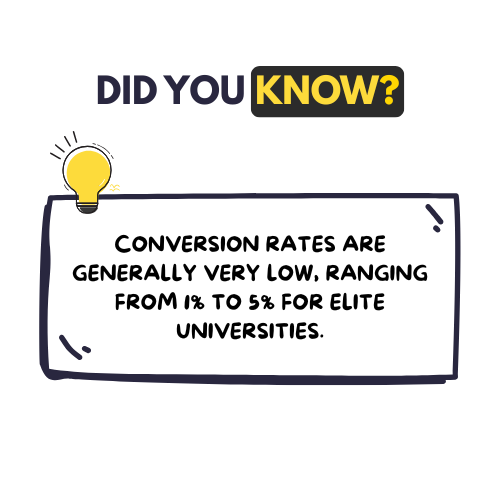After months of hard work, you’ve finally submitted your applications. You have been waiting for the response, and you hear “nothing”. You’re neither accepted nor rejected, so what happened? Well, there’s another possibility that you may have missed: you might be placed on the college waitlist. This happens when you meet the admission requirements, but the college has already accepted the maximum number of students it can accommodate. If a spot becomes available later, you may be offered a place.
Being on the waitlist is like standing on the bridge of uncertainty. Unaware of your chances of acceptance, you are not sure where the bridge will end. Being on the waitlist can bring both hope and confusion. You haven't been rejected outright, but your spot isn’t guaranteed. And the answer can be both good news and bad news. Although being waitlisted is not a final offer, it still offers a chance, your last shot at admission if you make the right moves. So, what should you do next?
This blog aims to guide you on that precisely. Keep reading to learn how waitlists work and discover simple steps you can take to improve your chances. We want to help you navigate the ups and downs of the process and hopefully turn that waitlist spot into good news with an acceptance letter.
Was I waitlisted because I met some but not all the requirements of the College?
Not really, being waitlisted means you've met a college's admissions criteria, but there isn't an available spot in the current incoming class. This often happens when there are more applicants than spots to fill. As more students apply to colleges, being waitlisted has become a common experience for many. If you're on the waitlist, you'll need to decide whether to accept that position or to explore other options and attend a different school. When an admitted student declines their offer, it creates an opportunity for someone else on the waitlist to join. Whatever your decision is, be sure to notify the college about it!
And if you’ve accepted your spot on the waitlist, here are a few things that you can do
Get an insight into your acceptance prospects
Reach out to the admissions office or visit the college’s website to see if they rank waitlisted students or have a priority list. Most colleges are willing to inform you of your status. Remember, the higher your position on the list, the better your chances of acceptance!
Write a letter of Continued Interest
Be your advocate! The college has already decided that you meet their admission requirements. Now, focus on highlighting any additional academic achievements or nonacademic factors that could strengthen your position. Express your enthusiasm and interest in attending the college. Make a compelling case for why you are a good fit. Since yield rates matter to colleges, you can also mention that you'll enrol if accepted.
Update Your Application
If you have recent academic improvements or notable achievements, inform the admissions office to increase your chances. A few things that you can add to your application are:
- Improved Grades: Even if your grades have improved mid-year, don’t be shy to send the transcript!
- Higher Test Scores: If you retook the SAT or ACT and achieved better results, send them!
- New Awards or Achievements: Any competitions won, honours received, or leadership roles undertaken, yes, you guessed it, send them!
- Additional Strong Recommendation: If a teacher has noticed significant growth in your performance, ask them to write a supplementary letter.
Stick to your studies
This isn't the time to slack off. If you're waitlisted, your grades from the third and fourth quarters might be reassessed.
Stay engaged
Show the admissions team you're dedicated to sports, clubs, and other activities. Remember, you've already achieved something.
Secure Your Place at Your Backup School
Make sure to meet the acceptance deadline for your Plan B School if you want to keep that option open. Missing this deadline could mean losing your spot there!
Unfortunately, accepting a spot on the waitlist at another school might mean you would need to forfeit your deposit at the Plan B School.
Consider Your Choices
When you are on a waitlist, the outcome is uncertain, so it's a good moment to consider alternative options, ask yourself these two questions
- Might another college serve as a better stepping stone towards my dream?
- Could taking a year for work, travel, or focused study enhance my experience?
Consider Consulting Experts
You can also discuss these things with your counsellor, who can guide you about your potential options and which school suits your dreams and aspirations better. CounsellingX has over 550 expert counsellors with decades of experience in admissions counselling. Having helped thousands of students and worked with the admissions officers of top universities, the counsellors can predict your chances and guide you exactly where you stand on the waitlist.
What You Should Not do When you’re on the Waitlist
Although we have talked about the steps that may increase your chances, it’s important to recognise actions that may be counterproductive:
Repeated Calls or Emails: Excessive communication with the admissions team can be counterproductive. While it's understandable to feel anxious about your application, constantly calling or emailing may appear overly eager or annoying.
Instead, send concise, timely inquiries only when you genuinely need assistance or clarification.
Unnecessary Updates: Be thoughtful about the information you share after submitting your application. Feel free to update them with new, meaningful details that truly showcase your achievements, like awards, projects, or unique experiences that weren’t mentioned before. To keep things clear and impactful, try to avoid sending minor updates or repeating information, as this might make your application seem less focused. Remember, presenting your most important accomplishments can make your application stand out in the best way.
Keep your Counsellor Out of the Loop: Staying in touch with your counsellor during this time is really helpful. They can provide valuable support, guidance, and insights about your waitlist situation. Sharing any updates you plan to send to the admissions office with them can give you their helpful perspective. They might also have suggestions on the best way to handle things or which achievements to highlight, helping you make the strongest case.
Why do Colleges Waitlist Students in the First Place?
Colleges use waitlists as a strategic method to handle fluctuating enrollment numbers while preserving academic standards, diversity, and institutional goals. Here’s a breakdown of why they rely on waitlists:
|
Control Enrollment |
|
Protect Yield Rate |
|
Preserve Class Balance |
|
Account for Unpredictability |
|
Maintain Prestige |
|
Keep Good Candidates |
- To Control Enrollment (Yield Management)
Colleges often face uncertainty about how many admitted students will actually enrol. A waitlist serves as a safety net to fill vacancies if fewer students accept offers than anticipated. This strategy helps colleges meet their target class size without over-admitting students.
- To Protect Their Yield Rate
By waitlisting borderline applicants instead of accepting them immediately, colleges maintain their yield rate.
- To Preserve Class Balance
Colleges aim for a diverse and balanced student body across academic interests, geography, and demographics. If the admitted class lacks a certain demographic profile, colleges can select specific students from the waitlist to achieve balance.
- To Account for Unpredictability
With students applying to more colleges than ever, predicting who will accept offers is challenging. Waitlists offer flexibility during unpredictable admission cycles.
- To Maintain Institutional Prestige
Selective colleges prefer to seem exclusive. Using waitlists instead of outright rejection helps keep admit rates low and indicates that "you were good, just not quite enough."

- To Keep Good Candidates in Play
A waitlist acts as a soft ‘maybe’ for strong applicants who may not have fit due to space limitations, institutional needs, or competition.
Final Thought
Being held on a college waitlist can feel like being in limbo, but it also shows your application was strong enough to reach the final stage. Don’t lose hope. Use this period wisely, stay optimistic, and take purposeful steps. Whether the waitlist results in an offer or not, remember: your value isn’t determined by one decision. Your journey to success might follow a different path, but it remains yours to own, shape, and shine in.
Frequently Asked Questions
1. How long can I expect to wait before receiving an update?
Colleges typically inform students about waitlist decisions between early May and late July, though in some rare cases, responses may extend into August. Most updates usually occur after the May 1 deadline, when high school seniors must submit deposits to confirm their spots at other colleges.
2. What are the most common reasons students are ultimately not offered admission from the waitlist?
Students often aren't admitted from the waitlist because colleges may have already met their enrollment goals and no longer require additional students. Others might be further down the waitlist, lack recent updates on academics or extracurricular activities, or fail to demonstrate ongoing interest, such as not submitting a Letter of Continued Interest or missing deadlines. Colleges also utilise the waitlist to fulfil specific needs like major, geographic region, or diversity. If a student’s profile doesn’t align with these criteria, they might not be chosen. Additionally, a decline in academic performance can negatively impact their chances.
3. How do colleges decide who gets off the waitlist?
Understanding each college’s process can be difficult. You can reach out to the admissions office or check the college’s website to see if they rank or prioritise waitlisted students. Being ranked higher improves your chances of moving off the waitlist. On the other hand, some colleges may not rank waitlisted students or assign priority. Instead, they might use a holistic approach, considering factors like the majors they aim to fill.
4. What Are My Chances of Being Accepted from the Waitlist?
According to data from the National Association for College Admission Counselling, colleges generally accept about 25% of students on the waitlist. The percentage for the top schools is around 5%. Since the decisions are released weeks before the fall term starts, students usually do not have clear information on how many students are accepted from the waitlist each year.
5. Is a waitlist a rejection?
Despite common fear, being on the waitlist does not mean that you are rejected. The meaning of being waitlisted is straightforward: you haven't received an offer of acceptance, nor have you been rejected.











